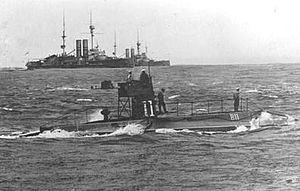Name HMS B11 Launched 1906 Beam 4.1 m | Fate Sold for scrap 1919 Height 12 ft (3.7 m) Length 43 m | |
 | ||
Displacement 280 tons surfaced313 tons submerged Propulsion petrol engine, single propeller | ||
HMS B11 was the last boat of the Royal Navy's B-class of submarines. Launched in 1906, it is best known for carrying out a successful attack on the Ottoman battleship Mesûdiye in the Dardanelles, an action for which her captain received the Victoria Cross. It spent the remainder of its active life serving in the Mediterranean, being converted into a surface patrol craft late in the war.
Contents
Pre-war career
The submarine was constructed by Vickers in Barrow and was launched on 24 February 1906. Fitting out was completed 11 July the same year.
Along with HMS B9 and HMS B10 the submarine was deployed to Malta in 1912.
Patrolling off the Dardanelles
In September 1914 the submarine was redeployed to Tenedos join the fleet watching the entrance of the Dardanelles.
Later in 1914 while on patrol off the Dardanelles B11 chased a torpedo boat for 4 miles up the straight.
In April 1915 after HMS E15 ran aground off Kephez point, HMS B11 was one of a number of boats to attempt to destroy the wreck. The attack failed.
On 20 May 1915 HMS B11 sighted SM UB-8 while on patrol off the Gulf of Smyrna. HMS B11 attempted to attack but was spotted and SM UB-8 then dived before escaping.
Attack on the Mesudiye
On 13 December 1914, B11, commanded by Lieutenant Norman Douglas Holbrook, entered the Dardanelles and torpedoed the Ottoman battleship Mesûdiye.
B11 had been selected for the mission over HMS B9 and HMS B10 due to having been fitted with a new battery. The French boats at the submarine base had been rejected as it was agreed that they were less suitable than the British submarines. Guards were constructed over the various projections on the submarine's hull to reduce the risk of snagging on mines.
B11 started its journey from Tenedos. Before the submarine reached the first row of mines it was discovered that one of the guards had become damaged making it worse than useless. The guard was removed and the attack continued. B11 then had to pass under five rows of mines through then uncharted currents. Passing through the minefield took about five hours. After B11 hit Mesûdiye it took eight hours for the submarine to escape initially with any attempt to use the periscope resulting in heavy fire.
Lt. Holbrook was awarded the Victoria Cross, the first for service in a submarine, his First Lieutenant, Sydney Winn, was awarded the Distinguished Service Order, and every member of the crew was awarded the Distinguished Service Medal.
On 24 July 1916 the Prize court decided that the submarine's company was entitled to prize money for the sinking of Mesûdiye, and an award of £3,500 was made, of which Holbrook received £601 10s 2d, Win £481 4s 2d, chief petty officers £240 12s 1d, and seamen £120 6s 1d. This represented three years' pay for a seaman. On 24 August 1915 the town of Germanton in New South Wales, Australia, was renamed "Holbrook" in his honour and a replica of B11 can be seen there.
Move to Venice
The submarine was relocated from Malta to Venice in October 1915 arriving on the 28th. On 11 December of the same year the submarine under the command of Lieutenant Samuel Gravener was engaged by an Austrian flying boat. The attack was unsuccessful and the plane suffered engine failure forcing it to land. Gravener attempted attack the plane with a Maxim gun but it jammed and the plane was able to take off again before the submarine could ram it.
On 17 January 1916 the submarine managed to capture the crew of an Austrian flying boat after the aircraft had suffered engine failure while returning from a bombing raid. On 17 March it was narrowly missed by a torpedo but was unable to locate the attacker.
Later in the war B11 was converted to a surface patrol craft through raising the deck level and removing the electric motor. In addition the conning tower was replaced by a wheelhouse.
B11 was sold for scrap in 1919 in Italy.
